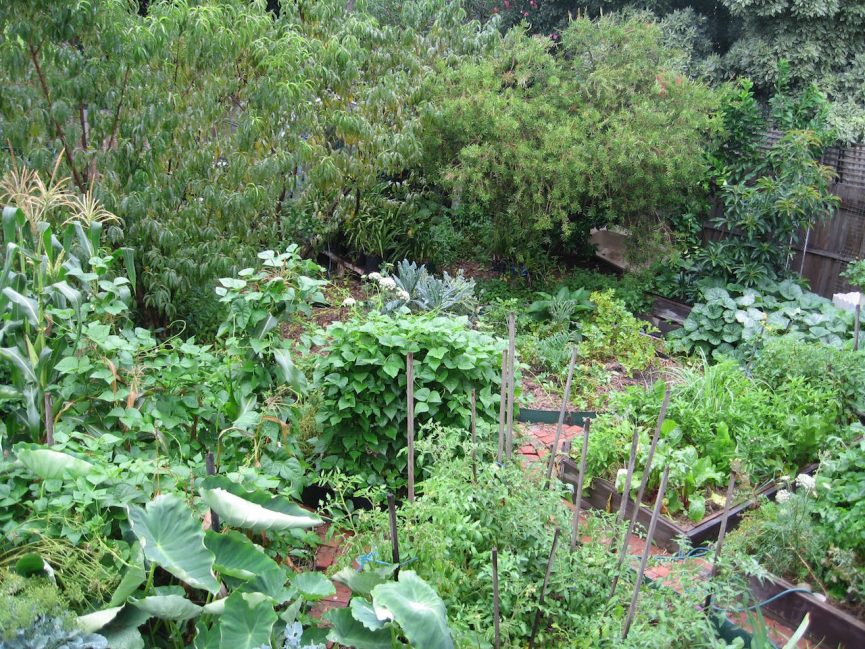We each have our own preferences for food, location and climate…well so do our plants. They all have things they need, things they use and things they don’t, not to mention things that like to eat them. So what happens if we grow the same thing in the same place every year?
Well – we deplete the soil of the things that the plant uses a lot of, making relatively abundant the things that it doesn’t and make the perfect situation for bugs to just wait until you plant their favorite meal again. All in all a great way to reduce soil health and in turn the vitality and productivity of your garden.
You can try and fight against this by adding nutrients to the soil, using pesticides to kill the bugs and diseases and so on but this is fighting against the symptoms not the causes which means eventually you lose. You can also emulate the natural system of poly-culture (which we’ll loosely translate into many species) through approaches like guild planting or food forests but that’s another topic entirely. On this page we’re talking a place to start for the beginning gardener… crop rotation.
Crop rotation has been around for thousands of years. It was originally just the idea of leaving a field fallow (empty) in between seasons but since then has developed into a myriad of ways to rotate crops around a number of fields (or spaces) with the intent of improving soil health, decreasing the need to treat pest ‘symptoms’ by keeping diversity in what is planted where and ideally increase the productivity of your garden.
So some basic ideas to start with:
- If we only plant a certain crop in the same space every two years pests can’t get a foothold as they don’t have a consistent ‘food supply’
- Some plants are heavy feeders, some aren’t so we need to plant the heavy feeders when there is a lot of available nutrition
- There are synergies between crops, for example deep rooted crops break up the soil which may make (without any additional effort) the space suitable for a crop that revels in an airy soil.
Crop rotation can get endlessly complicated and to be honest there is so much information that is contradictory that it can get very confusing so we’ll walk through an application of it.
Step 1: Work out what you want to grow
There’s no point planning to plant something that you aren’t going to eat so work out what you like eating.
Step 2: Group your families
Plants can be divided into a number of families depending on their characteristics. This is an entire science in its own right so let’s simplify it down to some of the main players. We’re also going to break them up into light feeding and heavy feeding which refers mostly to how much nitrogen in the soil they need to thrive and be productive.
Light Feeding Families
| Legumes | Allium | ||
| Anything with a pod and a bean. These plants have a special super-power in that they have a relationship with a special fungi that makes nodes on their roots and allows them to fix nitrogen into the soil that can then be used by other plants | The onion family. These folk tend to be light feeders and have relatively shallow roots and even some anti-bacterial effect on the soil they grow in. | ||
| Peas
Climbing beans |
Bush beans
Snow peas |
Chives
Garlic Leek |
Spring onions
shallots |
Heavy Feeding Families
| Brassicas | Fruiting Vegies | ||
| A heavy feeding family which loves really rich soil. For ease of planning we’re also going to include in this group another family which includes spinach and silverbeet even though they’re not actually brassica’s. | If you’re like me then this is the whole reason you garden. These are the fruiting vegetables like tomatoes and cucumbers. This is actually a bit of a mixture rather than a family (in the botanical sense) but they are all heavy feeders. We’ve also included corn in this group for simplicity. | ||
| Kale
Cauliflower Cabbage Broccoli Brussels sprouts Kohl Rabi |
Radish
Swede turnip Mustard Beetroot Silverbeet Spinach |
Potatoes
Tomatoes Eggplant |
Capsicum
Chillies Corn Globe artichokes |
Other Groups
| Space Fillers | Green Manure |
| If you have lots of space then you can have beds dedicated to these compact plants but I tend to use lettuces/endive and carrots to fill spaces between other plants. Herbs are also good for this purpose and may appreciate the shade particularly in summer. | This isn’t actually a family as it’s mostly made up of legumes but it’s different in the purpose of this crop. We mentioned that legumes fix nitrogen and increase soil fertility. Green manure are legumous crops grown and then dug back into the soil like a living, soil enriching compost. If you’re planting green manure (and there are summer or winter versions) don’t wait too long (ie don’t wait until they set seeds of pods) as the nitrogen that you want to return to the soil is pumped into those lovely pods of goodness.
|
| Lettuce
Endive Carrots Celery Celeriac |
Step Three: How many beds do you have?
What is your space actually like? This is important as it will inform how you arrange the families. Remember that a bed doesn’t actually have to be separated as such. For example I have four large ‘L’ shaped beds but I divide each of the legs of the ‘L’s as their own beds. This gives me 8 beds which I find easier to plan for.
Step 4: Make a plan
So now that we’ve met the cast how do we arrange them? Well there are a million ways but hopefully if you’ve got to this point you actually have a pretty good idea of how this is going to work ie:
- Try to avoid following planting the same family twice
- Try to have a legume (or at least a light feeder) before a heavy feeder as they enrich the soil and you can you use spent leaves to further provide mulch and nutrients is dug in. If this isn’t convenient think about compost and manure before planting a heavy feeder.
- Try to plan to have a green manure crop in each bed once every two years
So a simple rotation, bearing in mind summer and winter seasons

In my bed I have two four bed rotations (which makes 8 beds) and it looks something like this:
| Autumn | Garlic and Onions (alliums) | Leeks and shallots (alliums) |
| Spring | Turnips and swedes (Brassicas) | Corn, parsnip and pumpkin (other) |
| Autumn | Broccoli and Cabbage (Brassica) | |
| Spring | Potato (early spring) and then compost | Leek, spring onions and climbing beans |
| Autumn | Brussel sprouts, cabbage, kale cauliflower (Brassica) | Peas, mange tout (legume) |
| Spring | Bush beans, leeks and spring onions (Legume) | Cucumber, eggplants, zucchini and capsicum (fruiting) |
| Autumn | Broad Bean (Legume) | Green manure and compost |
| Spring | Tomato, basil and celery (Other) |
One more comment about poo!
Well compost and manure to be honest. Your heavy feeders will love a well composted bed but rooting families not so much. If you are planning to grow potatoes in particular then try and avoid a fresh and heavy feed before you plant.
A couple of final suggestions:
- Research, but don’t wait for ‘THE’ answer. There is a lot of advice out there, some of it really confusing and some of it completely contradictory.
- Don’t get too hung up on details. Nature isn’t always neat and easily divided into boxes and things are going to mess with your plan (“ but you said don’t follow two heavy feeders and in your plan you’ve got brassicas potatoes then brassicas again…WTH!). The aim is to improve soil fertility and get a product from our garden so if it doesn’t fit the rules exactly don’t stress, make a plan and then see how it goes which leads us on to…
- WRITE IT DOWN!: sorry to yell but as the myth busters say “the difference between screwing around and science is writing it down!”. Every garden is different and the interactions are complicated so write down your plan and then make notes of how it goes. What thrived? What didn’t? What got attacked by bugs? When did things start fruiting and what advice would you give yourself 12 months into the future? Writing it down will make your garden more productive and you a better, more in-tune gardener.
- Nature likes diversity. As well as crop rotation some things work really well together either in terms of filling a gap or relating to each other. The old combination of corn to grow up, beans to grow on it and pumpkin to grow under it is good advice but it’s going to mess with rigid crop rotation. Think of what the primary component is and just go from there.
- Remember herbs and flowers. A truly productive garden doesn’t just grow stuff it provides aesthetics, habitat and whole lot more so don’t forget some flowers for your vase (and your bees) and some herbs the family apiaceae (carrots, endive, dill, fennel, coriander, parsley etc) are particularly loved by bees when they go to seed. So if a plant bolts maybe think about leaving one to go to seed, you’ll not only get great seeds but your bees will love you!
Good luck.

